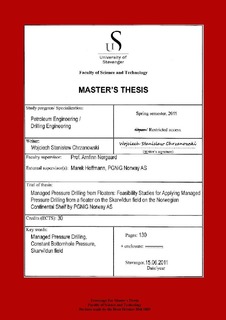| dc.contributor.author | Chrzanowski, Wojciech Stanislaw | |
| dc.date.accessioned | 2013-07-02T09:23:53Z | |
| dc.date.available | 2013-07-02T09:23:53Z | |
| dc.date.issued | 2011 | |
| dc.identifier.citation | Conf til 2013 | no_NO |
| dc.identifier.uri | http://hdl.handle.net/11250/183392 | |
| dc.description | Master's thesis in Petroleum engineering | no_NO |
| dc.description.abstract | Managed Pressure Drilling (MPD) is a relatively young technology that has improved some
old ideas of Underbalanced Drilling (UBD). According to the IADC, MPD is an “adaptive
process used to precisely control the annular pressure profile throughout the wellbore.
The goal is to ascertain the downhole pressure environment limits and to manage
the annular pressure profile accordingly”. In other words the main aim of MPD is to avoid
continuous influx of formation fluids to the surface by maintaining a state of effective
overbalance. It’s done by applying surface backpressure during drilling ahead or shut-in
to make a connection of jointed pipe. Basic tools required to conduct MPD are: a rotating
control device (RCD), drillstring non-return valves and dedicated choke manifold.
MPD allows drilling through the un-drillable in conventional way formations,
helps to reduce non productive time (NPT) and to overcome several drilling problems like:
drilling with narrow “pressure window” and kick-loss scenarios caused by narrow margins,
excessive casing program, low ROP, excessive mud cost caused by the loss of circulation,
failure to reach TD with large enough hole diameter and shallow geohazards both with
drilling riserless and with casing or marine riser. This technology enables manage pressures
through the wellbore in more precise way than conventional drilling and there are several
strong indicators that MPD in marine environments will be a breakthrough technology in
offshore industry in the next years. It’s a big chance for MPD to be best solution for drilling
in reservoirs with narrow pressure window, drilling with troublesome zones, depleted
reservoirs, HP/HT reservoirs and to overcome almost all offshore drilling-related challenges.
Therefore the main objective of this Master’s Thesis is to evaluate both technical
and economical feasibility of using Managed Pressure Drilling technology from a floating
drilling rig on the Skarv/Idun field on the NCS. Furthermore to show which MPD variation is most suitable on this field, equipment needed to conduct MPD operations, evaluates reservoir and drilling related benefits and assess which drilling problems can be avoided using Managed Pressure Drilling technology. | no_NO |
| dc.language.iso | eng | no_NO |
| dc.publisher | University of Stavanger, Norway | no_NO |
| dc.relation.ispartofseries | Masteroppgave/UIS-TN-IPT/2011; | |
| dc.subject | petroleumsteknologi | no_NO |
| dc.subject | managed pressure drilling | no_NO |
| dc.subject | skarv idun field | no_NO |
| dc.subject | pgnig norway as | no_NO |
| dc.subject | constant bottomhole pressure | no_NO |
| dc.subject | MPD | no_NO |
| dc.title | Managed pressure drilling from floaters: feasibility studies for applying managed pressure drilling from a floater on the Skarv/Idun field on the Norwegian Continental Shelf by PGNiG Norway AS | no_NO |
| dc.type | Master thesis | no_NO |
| dc.subject.nsi | VDP::Technology: 500::Rock and petroleum disciplines: 510::Petroleum engineering: 512 | no_NO |
| dc.source.pagenumber | 130 | no_NO |
